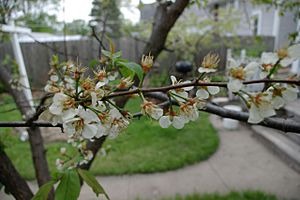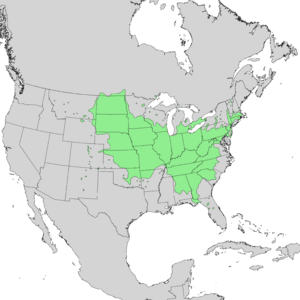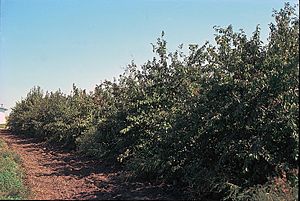American plum facts for kids
Quick facts for kids American plum |
|
|---|---|
 |
|
| Conservation status | |
| Scientific classification | |
| Genus: |
Prunus
|
| Species: |
americana
|
 |
|
| Distribution of Prunus americana | |
| Synonyms | |
|
|
The Prunus americana, often called the American plum or wild plum, is a type of Prunus tree. It grows naturally across a large part of North America. You can find it from Saskatchewan and Idaho in the west, all the way south to New Mexico, and east to Québec, Maine, and Florida.
This plum tree is sometimes planted in new areas and can even grow wild there. People sometimes confuse it with the Canada plum (Prunus nigra). However, the American plum's fruit is smaller, rounder, and bright red, while the Canada plum's fruit is yellow. Many types of cultivated plums come from this species. It's also a great base for grafting other domestic plum varieties.
Contents
About the American Plum Tree
The American plum grows as a large bush or a small tree. It can reach up to 4.5 meters (15 feet) tall. This plant prefers sandy or medium-textured soils. It does not grow well in heavy clay soils.
This shrub can handle cold winters very well. However, it doesn't like too much shade, dry weather, or fires. It grows fastest in the spring and summer. Its beautiful flowers bloom in the middle of spring. The plant spreads naturally from its seeds. It grows into a group of trees slowly because it takes a long time for seeds to become mature plants.
The roots of the American plum are shallow and spread out widely. They also send up new shoots called suckers from the ground. The tree has many stems that become scaly as they get older. Its top part, called the crown, is wide. The branches have thorns.
The leaves grow one after another along the stem. They are oval-shaped and usually 5 to 10 centimeters (2 to 4 inches) long. The top of the leaf is dark green, and the bottom is smooth and pale. The small white flowers have five petals. They grow alone or in small groups where the leaves meet the stem. The round fruits are about 2.5 centimeters (1 inch) across.
Plum Tree Family and Hybrids
Some types of Prunus americana are actually different species. For example, Prunus americana var. lanata is now known as Prunus mexicana. Also, Prunus americana var. nigra is now called Prunus nigra.
The Chickasaw plum (Prunus angustifolia) can naturally mix with P. americana. When they do, they create a new hybrid plant called P. × orthosepala.
People have also created many new plum types by crossing the American plum with other Prunus species. This includes mixing it with the peach (Prunus persica).
How People and Animals Use It
The American plum is useful for both its beauty and its fruit. Its white flowers make it look lovely in the spring. Its shape makes it a popular tree for yards. Sargent, a famous plant expert, said the American plum is very valuable as a decorative plant. He noted its graceful branches, white flowers in spring, bright leaves, and many colorful fruits. More than 200 different types of American plum have been grown by people.
The fruit can be both sour and sweet. People eat it fresh or use it to make preserves, jellies, jam, and wine.
Farmers use these medium to tall shrubs or trees as windbreaks. They also plant them along highways or rivers. The thick growth of the trees helps slow down wind near the ground. The new shoots from the roots make the American plum good for holding soil in place along stream banks and in ditches. It can even survive several days of flooding. Some businesses plant these trees along their entrance roads.
Many birds and animals enjoy eating the fruit. Both white-tailed deer and mule deer eat the twigs and leaves.
Native Americans used the American plum a lot in the past. Eastern Native American tribes planted many of these trees. This led to many places being named "Crab Orchard."
The Plains Indians and Cheyenne tribes ate the plums. The Cheyenne also used the branches for their Sun Dance ceremony. The Navajo used the roots to make a red dye.
In Stories
American plums are mentioned in Laura Ingalls Wilder's book On the Banks of Plum Creek (1937). She describes how to pick them:
You must know exactly how to shake a plum tree. If you shake it too hard, the green plums fall, and that wastes them. If you get all the ripe plums. In the night they will fall, and some will smash and be wasted.
Laura learned exactly how to shake a plum tree. She held its scaling-rough bole and shook it, one quick, gentle shake. Every plum swung on its stem and all around her they fell pattering. Then one more jerk while the plums were swinging, and the last ripe ones fell plum-plump! plum-plump! plump! plump!
There were many kinds of plums. When the red ones were all picked, the yellow ones were ripe. Then the blue ones. The largest of all were the very last. They were the frost plums, that would not ripen until after frost.
See also
 In Spanish: Prunus americana para niños
In Spanish: Prunus americana para niños



